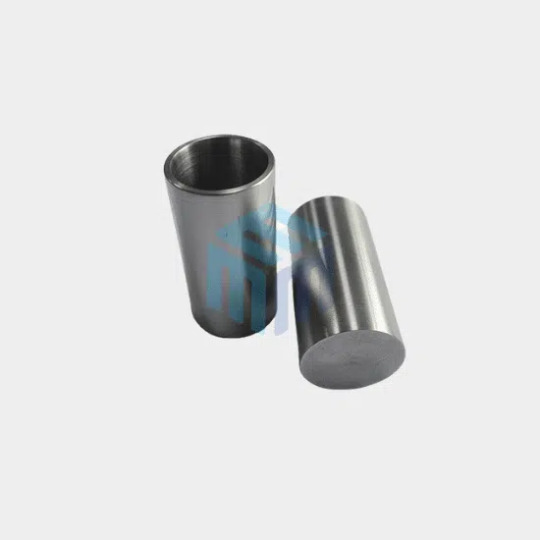#Sintering
Explore tagged Tumblr posts
Text

Sintered salt (NaCl)
Processing The salt has been compacted (20MPa) and sintered for four hours at 785 degrees C Applications A sintered preform of salt can be used as a preform in the investment casting of open celled metal foams. The preform can then be washed out. Sample preparation The sample has been sputter-coated with gold Technique Scanning electron microscopy (SEM) Length bar 140 μm Further information The interconnectivity of pores in the reticulated aluminium foam was found to be strongly dependent on the degree of sintering of the salt. The sintering occurs by a non-densifying mechanism but the necks grow progressively wider with time. Four hours provides sufficient interconnectivity for the salt to be readily washed-out. Contributor J A Curran Organisation Department of Materials Science and Metallurgy, University of Cambridge
Source.
#Materials Science#Science#Ceramics#Salt#Magnified view#Scanning electron microscopy#Foams#Sintering#University of Cambridge#DoITPoMS
26 notes
·
View notes
Text
Applications of Molybdenum Crucibles:

Materials Processing: Molybdenum crucibles are widely used in high-temperature applications such as melting and casting metals, alloys, and other materials. They are suitable for processes involving the production of superalloys, exotic metals, and high-purity materials.
Single Crystal Growth: Molybdenum crucibles are used in various crystal growth methods, including the Czochralski (CZ) and float-zone (FZ) techniques. They provide a clean and stable environment for growing high-purity single crystals of materials like silicon, sapphire, and other semiconductors.
Vacuum and High-Temperature Furnaces: Molybdenum crucibles are used in vacuum furnaces and high-temperature furnaces for applications such as sintering, heat treatment, and brazing of materials that require elevated temperatures in controlled atmospheres.
Chemical Analysis: Molybdenum crucibles are used in analytical chemistry and spectroscopy for sample preparation and chemical analysis. They are suitable for the heating and digestion of samples for analysis.
Powder Metallurgy: Molybdenum crucibles are used in the sintering and consolidation of metal powders and ceramics in the powder metallurgy process.
Aerospace and Defense: Molybdenum crucibles are employed in specialized aerospace and defense applications, particularly for the production of high-performance alloys and materials used in aerospace and defense systems.
Laboratory Research: Molybdenum crucibles are used in various laboratory applications, including metallurgical research, material testing, and high-temperature experiments.
Molybdenum crucibles also have excellent temperature and atmosphere resistance capacities, although they have slightly lower melting points compared to pure tungsten. Here’s an overview of the temperature and atmosphere resistance of molybdenum crucibles:
Temperature Resistance:
Molybdenum has a melting point of approximately 2,623 degrees Celsius (4,753 degrees Fahrenheit), which is significantly higher than most other common materials.
Molybdenum crucibles can withstand very high temperatures and are often used in applications that require extreme heat, such as the melting and casting of various metals and alloys.
Atmosphere Resistance:
Molybdenum exhibits good resistance to chemical reactions and corrosion in many atmospheric conditions, including inert and reducing gas environments. It is particularly well-suited for use in a vacuum or inert gas.
However, like tungsten, molybdenum can react with oxygen at elevated temperatures. When exposed to oxygen or oxidizing atmospheres, molybdenum can form molybdenum oxide, which can lead to embrittlement and degradation of the crucible. Therefore, it’s important to limit its use in oxygen-rich environments.
Molybdenum crucibles are commonly used in various high-temperature applications, including the production of sapphire crystals, melting and casting of metals, and thermal evaporation processes. Their combination of high-temperature resistance and resistance to many atmospheres makes them a popular choice for these applications.
As with any material, the specific temperature and atmosphere resistance of molybdenum crucibles can be influenced by factors like crucible size, design, and the presence of impurities. Manufacturers typically provide recommendations for the safe usage of molybdenum crucibles in different environments, so it’s advisable to consult with the manufacturer or supplier to ensure you are using the crucible within its specified resistance limits for your particular application.
Molybdenum crucibles are valued for their ability to withstand extreme temperatures and harsh chemical environments, making them essential tools in a range of industries where high-temperature materials processing and materials research are critical.M-Kube Enterprise is an Australian company catering customized laboratory products, laboratory consumables and laboratory solutions in Australia, New Zealand, Singapore, Malaysia, South Korea, India, Dubai, Philippines, Indonesia and Vietnam.
#MolybdenumCrucibles#HighTemperatureApplications#MaterialsProcessing#SingleCrystalGrowth#CzochralskiMethod#FloatZoneTechnique#VacuumFurnaces#HighTemperatureFurnaces#Sintering#HeatTreatment#Brazing#ChemicalAnalysis#Spectroscopy#PowderMetallurgy#AerospaceApplications#DefenseMaterials#TemperatureResistance#AtmosphereResistance#Superalloys#ExoticMetals#HighPurityMaterials#SemiconductorManufacturing#SapphireProduction#ThermalEvaporation#CorrosionResistance#MolybdenumProperties#IndustrialApplications#MKubeEnterprise#LaboratorySolutions
0 notes
Link
Our metallurgical history is a little bit like a game of Rock, Paper, Scissors, only without the pap...
#originaltags#apt#beneficiation#carbide#electrode#engineering#featured#interest#mining and refining#refractory#sintering#tungstate#tungsten#wolfram
0 notes
Text

Metal Sintering Services Project Report
Forging Tomorrow: Dive into the Metal Sintering Services Project Report. Transformative Precision in the Heart of Innovation, Shaping the Future of Metal Fabrication. ⚙️🛠️ #MetalSintering #InnovationForge #BizProjectReports #BusinessProjectReport #bizProjectReportsCom
0 notes
Text










Yellowstone National Park, WY (No. 23)
Yellowstone is at the northeastern end of the Snake River Plain, a great bow-shaped arc through the mountains that extends roughly 400 miles (640 km) from the park to the Idaho-Oregon border.
The volcanism of Yellowstone is believed to be linked to the somewhat older volcanism of the Snake River Plain. Yellowstone is thus the active part of a hotspot that has moved northeast over time. The origin of this hotspot volcanism is disputed. One theory holds that a mantle plume has caused the Yellowstone hotspot to migrate northeast, while another theory explains migrating hotspot volcanism as the result of the fragmentation and dynamics of the subducted Farallon Plate in Earth's interior.
The Yellowstone Caldera is the largest volcanic system in North America, and worldwide it is only rivaled by the Lake Toba Caldera on Sumatra. It has been termed a "supervolcano" because the caldera was formed by exceptionally large explosive eruptions. The magma chamber that lies under Yellowstone is estimated to be a single connected chamber, about 37 miles (60 km) long, 18 miles (29 km) wide, and 3 to 7 miles (4.8 to 11.3 km) deep. The current caldera was created by a cataclysmic eruption that occurred 640,000 years ago, which released more than 240 cu mi (1,000 km3) of ash, rock and pyroclastic materials.This eruption was more than 1,000 times larger than the 1980 eruption of Mount St. Helens. It produced a caldera nearly 5⁄8 mi (1.0 km) deep and 45 by 28 miles (72 by 45 km) in area and deposited the Lava Creek Tuff, a welded tuff geologic formation. The most violent known eruption, which occurred 2.1 million years ago, ejected 588 cu mi (2,450 km3) of volcanic material and created the rock formation known as the Huckleberry Ridge Tuff and the Island Park Caldera. A smaller eruption ejected 67 cu mi (280 km3) of material 1.3 million years ago, forming the Henry's Fork Caldera and depositing the Mesa Falls Tuff.
Source: Wikipedia
#Black Opal Pool#Midway Geyser Basin#Sapphire Pool#Yellowstone National Park#fauna#flora#travel#original photography#vacation#tourist attraction#landmark#landscape#countryside#subalpine forest#USA#summer 2024#Wyoming#UNESCO World Heritage Site#geothermal feature#geology#Yellowstone Plateau#Rocky Mountains#siliceous sinter#geyserite#Teton County#Upper Geyser Basin#Biscuit Basin Trail#Silver Globe Geyser Complex#Wall Pool#Firehole River
16 notes
·
View notes
Text
I can totally see the scene in “Avengers: Doomsday”…
Thor(sees Von Doom for the first time):…..Tony?
Von Doom: Who the hell is Tony?
(he blasts Thor with a magical weapon but Thor dives out of the way)
Thor(lying on his back on the ground):…..Well….I definitely didn’t see that coming.
(suddenly Loki appears above Thor and extends his hand to help him up)
Thor:…Well, I should’ve seen that coming…
#seriously tho I need them to do the Sinter Soldier reference that would be so perfect 😂😂😂#avengers doomsday#thor odinson#Tony stark#victor von doom#loki laufeyson#mcu
17 notes
·
View notes
Text

mutuals do this
7 notes
·
View notes
Text
genuinely what the fuck is wrong with bizly what inspired him to create the world of prime defneders and why did the rest of those sick fucks go with it and make such a gutwrenching fucking story i need financial compensation for this shit. oh my god
13 notes
·
View notes
Text








A few things from this month
☆A healed blast over from about 5 years ago
☆Engraved mirrors
☆A paper mache mask
☆A tattoo on synthetic skin
#tattoo#sinteric skin tattoo#mirror engraving#glass engraving#illustration#paper mache art#mask#sculpture#paper mache sculpture
4 notes
·
View notes
Text
Microfluidic technology has become increasingly important in many scientific fields such as regenerative medicine, microelectronics, and environmental science. However, conventional microfabrication techniques face limitations in scale and in the construction of complex networks. These hurdles are compounded when it comes to building more intricate 3D microfluidic networks. Now, researchers from Kyushu University have developed a new and convenient technique for building such complex 3D microfluidic networks. Their tool? Plants and fungi. The team developed a 'soil' medium using nanoparticles of glass (silica) and a cellulose based binding agent, then allowed plants and fungi to grow roots into it. After the plants were removed, the glass was left with a complex 3D microfluidic network of micrometer-sized hollow holes where the roots once were.
Read more.
#Materials Science#Science#Microfluidics#Biomaterials#Plants#Fungi#Sintering#Glass#Kyushu University
11 notes
·
View notes
Text

6 notes
·
View notes
Link
Our metallurgical history is a little bit like a game of Rock, Paper, Scissors, only without the pap...
#originaltags#apt#beneficiation#carbide#electrode#engineering#featured#interest#mining and refining#refractory#sintering#tungstate#tungsten#wolfram
0 notes
Text

#go here.#to the intake valve-seat#and there debase yourself#sintered copper nonsense#like it's fine for street app#just shut up
5 notes
·
View notes
Text


some guys in various states of despair + star
#angel.png#2025#ma'atsul#<idk if i had a tag fr that.#my ocs#alamiel#arsonist#love#mycelia#zephyr#sinter#star
6 notes
·
View notes
Text










Yellowstone National Park, WY (No. 29)
Eruptions average 100 feet (31 m) high, with some rare “superbursts” of 200 feet (61 m) or more. Eruptions last 45-60 minutes in a series of bursts. Great Fountain Geyser takes 10-14 hours to rebuild to an eruption. The pool slowly fills, then begins to overflow 70-100 minutes before the eruption.
Like most geysers, Great Fountain Geyser experiences periods of irregularity. For the most part, it is dependable. While waiting for its display, watch for the eruptions of White Dome Geyser.
Lower Geyser Basin
The Lower Geyser Basin sits on unstable glacial gravel on top of solid rock. The jarring energy of an earthquake can make the gravel vibrate and shift position, and compact or fracture.
All these changes affect water supplies to hot springs. They might force muddy water to the surface, clouding existing pools or creating new ones. They might divert water from a pool, causing it to dry up. Water temperatures might also increase or decrease due to these subsurface changes.
In the days after the Hebgen Lake earthquake of 1959, all of these changes were observed in various springs of the Firehole River geyser basins. The epicenter (point of origin) of the quake was determined to be about 31 air miles (50 km) northwest of the Fountain Paint Pots area.
Source
#White Dome Geyser#tourist attraction#cityscape#travel#USA#summer 2024#original photography#vacation#landmark#Midway Geyser Basin#Yellowstone National Park#fauna#flora#landscape#countryside#subalpine forest#Wyoming#UNESCO World Heritage Site#geothermal feature#geology#Yellowstone Plateau#Rocky Mountains#siliceous sinter#geyserite#Teton County#Firehole River#Great Fountain Group#Great Fountain Geyser
10 notes
·
View notes
Note
Sinter
He’s very polite and gentlemanly in his kiss. He takes his hat off and covers both your faces if anyone’s around to witness (maybe earning a few whistles from the gang)
It’s short and sweet but when you pull away he chases your lips for just one more before letting you go.
He can’t get enough.
6 notes
·
View notes